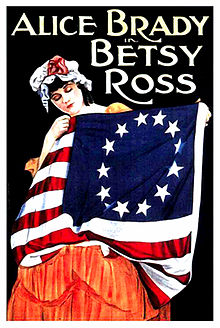Betsy Ross (film)
| Betsy Ross | |
|---|---|
 Film poster | |
| Directed by | Travers Vale George Cowl |
| Written by | Henry A. Du Souchet |
| Produced by | William A. Brady (of World Film) |
| Starring | Alice Brady |
| Cinematography | Max Schneider Arthur L. Todd |
| Distributed by | World Film Company |
Release date |
|
Running time | 60 minutes (5 reels) |
| Country | United States |
| Language | Silent (English intertitles) |
Betsy Ross is a surviving 1917 American silent historical film starring Alice Brady and produced and distributed by her father William A. Brady.[1][2]
Plot
As described in a film magazine,[3] Betsy Griscome (Brady), against the wishes of her Quaker parents, keeps a tryst with a British officer, Clarence Vernon (Mayo), who promises to marry her upon his return. Clarissa (Cook), her sister, falls in love and marries Joseph Ashburn (Bowers), a trader. Suspecting Vernon of duplicity, Joseph and Vernon fight a duel and Vernon is struck down. A year later Betsy marries John Ross (Kennard), and upon his death she operates a little shop for a living. Here she shields her sister, who was driven from home when she could not produce her marriage certificate. Betsy is commissioned by General Washington (MacQuarrie) to make the first American flag and later is accused of harboring a spy - in reality, her sister's husband. The film ends happily when all relations are explained.
Cast
- Alice Brady as Betsy Ross
- John Bowers as Joseph Ashburn
- Lillian Cook as Carissa Griscom
- Victor Kennard as John Ross
- Eugenie Woodward as Mrs. Ashburn
- Kate Lester as Mrs. Vernon
- Frank Mayo as Clarence Vernon[4]
- George MacQuarrie as George Washington[5]
- Justine Cutting as Mrs. Griscom
- Robert Forsyth as Samuel Griscom
- Nellie Fillmore as Mrs. Bass
- Richard Clarke as Lemuel Ketch
Reception
Like many American films of the time, Betsy Ross was subject to cuts by city and state film censorship boards. The Chicago Board of Censors required cuts of scenes of a sword thrust during the duel, killing of second man in duel, the two intertitles "Scarlet woman" and "Don't you dare kill the Vernon nigger," the scene with a duel vision, and the actual firing of the squad at the execution.[6]
References
Citations
- ^ The American Film Institute Catalog Feature Films: 1911-20 by The American Film Institute, c.1988]
- ^ Progressive Silent Film List: Betsy Ross at silentera.com
- ^ "Reviews: Betsy Ross". Exhibitors Herald. 5 (12). New York: Exhibitors Herald Company: 23. September 15, 1917.
- ^ Katchmer 2009, p. 240.
- ^ Stokes 2014, p. 10.
- ^ "Official Cut-Outs by the Chicago Board of Censors". Exhibitors Herald. 5 (13): 33. September 22, 1917.
Sources
- Katchmer, George A. (2009). A Biographical Dictionary of Silent Film Western Actors and Actresses. New York City: McFarland & Company. p. 240. ISBN 978-0786446933.
- Stokes, Melvyn (2014). American History through Hollywood Film: From the Revolution to the 1960s. London: Bloomsbury Academic. p. 10. ISBN 978-1441174291.
